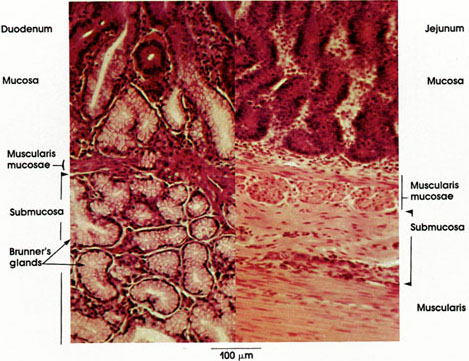

Plate 10.193 Duodenum and Jejunum
Ronald A. Bergman, Ph.D., Adel K. Afifi, M.D., Paul M. Heidger,
Jr., Ph.D.
Peer Review Status: Externally Peer Reviewed

Human, 10% formalin, H. & E., 162 x.
In this plate, the structure of the duodenum, and the jejunum can be compared. Both segments contain simple tubular glands composed of columnar epithelium separated by the connective tissue of the lamina propria. In the duodenum, note the presence of Brunner's glands in the submucosa, which are diagnostic for this segment of the small intestine. Brunner's glands are compound tubular and are composed of low columnar cells that secrete mucus. The secretory cells closely resemble the cells of the pyloric glands, which also secrete mucus.
Although these glands were first described in 1679 by J. J. Wepfer, Johann Brunner's father-in-law, credit is given to Brunner, the Swiss anatomist, who drew attention to them in his dissertation in 1687.
See also Plate 192.
Next Page | Previous Page | Section Top | Title Page
Please send us comments by filling out our Comment Form.
All contents copyright © 1995-2024 the Author(s) and Michael P. D'Alessandro, M.D. All rights reserved.
"Anatomy Atlases", the Anatomy Atlases logo, and "A digital library of anatomy information" are all Trademarks of Michael P. D'Alessandro, M.D.
Anatomy Atlases is funded in whole by Michael P. D'Alessandro, M.D. Advertising is not accepted.
Your personal information remains confidential and is not sold, leased, or given to any third party be they reliable or not.
The information contained in Anatomy Atlases is not a substitute for the medical care and advice of your physician. There may be variations in treatment that your physician may recommend based on individual facts and circumstances.
URL: http://www.anatomyatlases.org/